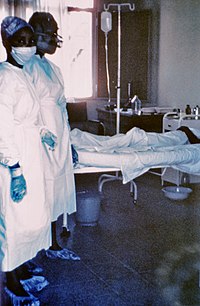
Photo from wikipedia
BackgroundThe ninth outbreak of Ebola Virus Disease (EVD) in the Democratic Republic of the Congo occurred in Équateur Province from 8 May-24 July 2018. A system of health facility (HF)-based… Click to show full abstract
BackgroundThe ninth outbreak of Ebola Virus Disease (EVD) in the Democratic Republic of the Congo occurred in Équateur Province from 8 May-24 July 2018. A system of health facility (HF)-based active case finding (ACF) was implemented in Mbandaka, a regional capital with four confirmed EVD cases, following completion of contact tracing. The goal of this HF-based ACF system was to look for undetected EVD cases among patients that visited HFs beginning one week prior to the system’s implementation.MethodsFrom 23 June – 24 July 2018, ACF teams visited HFs in Mbandaka and reviewed all medical records as far back as 17 June for any consultations meeting the suspected EVD case definition. The teams then assessed whether to validate these as suspected EVD cases based on factors such as recovery, epidemiological links, and their clinical judgement. ACF teams also assessed HFs’ awareness of EVD symptoms and the process for alerting suspected cases. We calculated descriptive statistics regarding the characteristics of reviewed consultations, alert cases, and visited HFs. We also used univariate and multivariate random effects logistic regression models to evaluate the impact of repeated ACF visits to the same HF on the staff’s awareness of EVD.ResultsACF teams reviewed 37,746 consultations, of which 690 met the definition of a suspected case of EVD. Two were validated as suspected EVD cases and transferred to the Ebola Treatment Unit for testing; both tested negative. Repeated ACF visits to the same HF were significantly associated with improved EVD awareness (p < 0.001) in univariate and multivariate analyses.ConclusionHF-based ACF during EVD outbreaks may improve EVD awareness and reveal many individuals meeting the suspected case definition. However, many who meet this definition may not have EVD, depending on the population size covered by ACF and amount of ongoing EVD transmission. Given the burdensome procedure of testing suspected EVD cases, future HF-based ACF systems would benefit from improved clarity on which patients require further testing.
Journal Title: BMC Infectious Diseases
Year Published: 2019
Link to full text (if available)
Share on Social Media: Sign Up to like & get
recommendations!